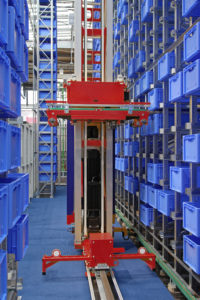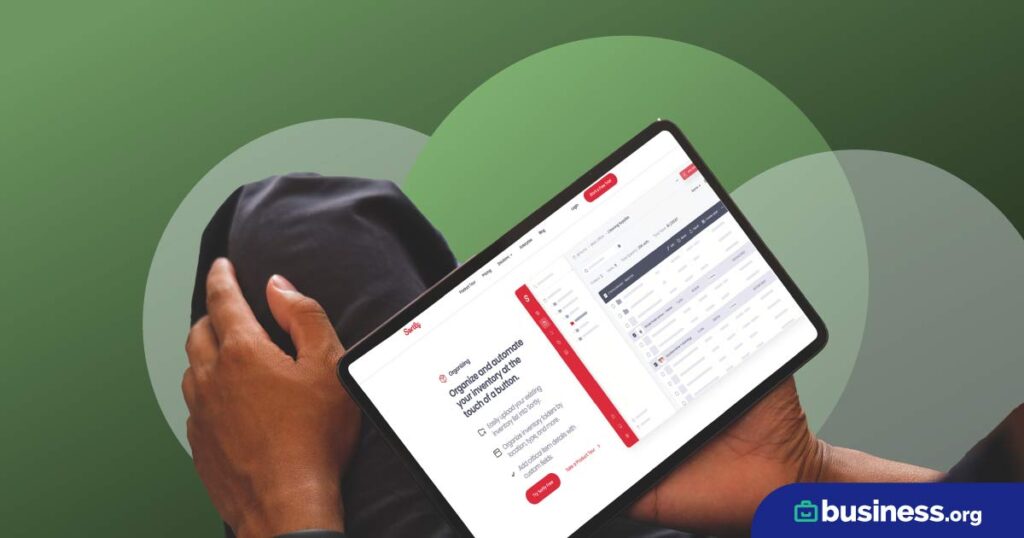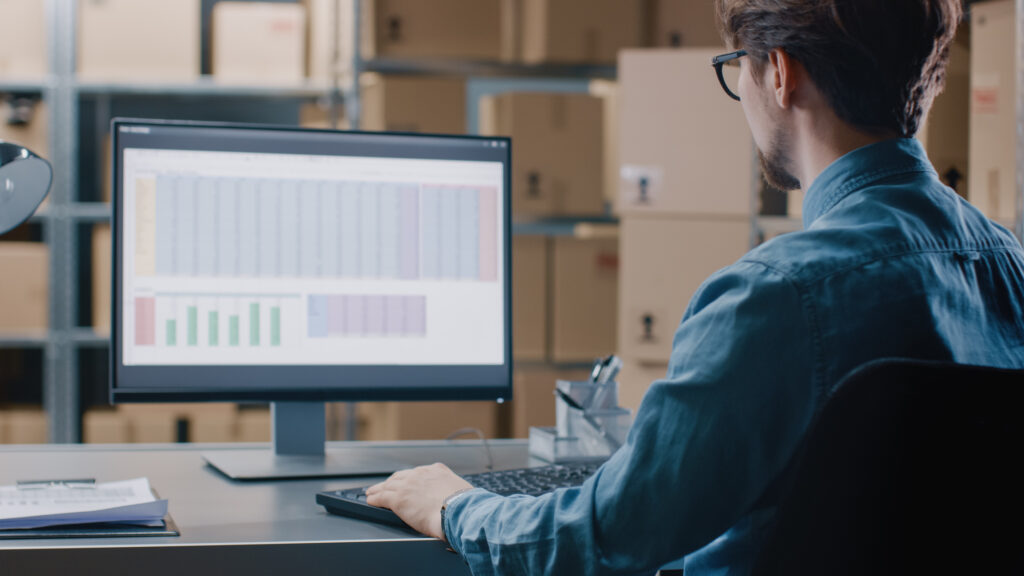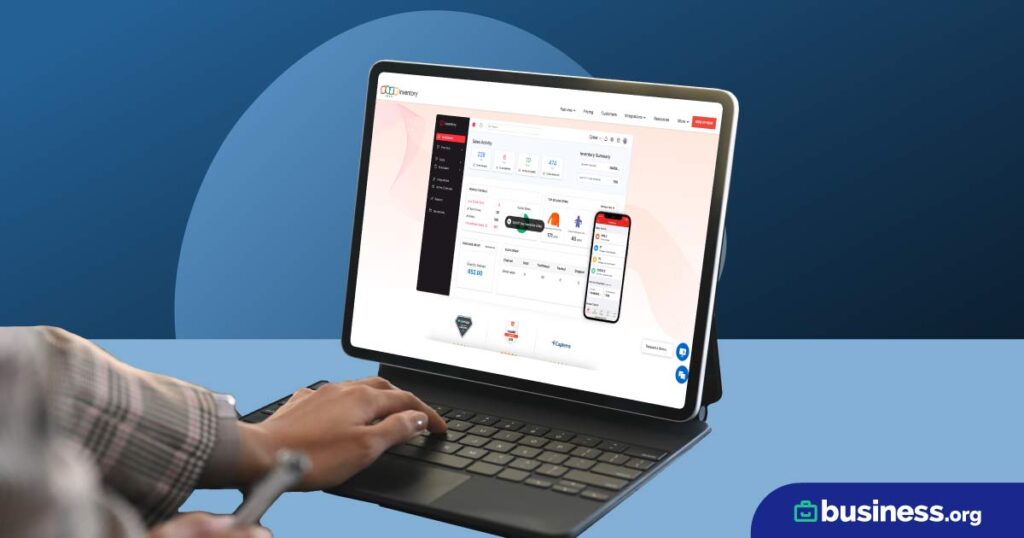We are committed to sharing unbiased reviews. Some of the links on our site are from our partners who compensate us. Read our editorial guidelines and advertising disclosure.
Inventory Management Acronyms and Terms to Know in 2025
Trying to find answers about business inventory management can be frustrating. Not only is it a complicated subject, but you’ve also got to deal with obscure terms that you may not understand (yet).
Business.org is here to help. We’ve compiled a glossary of commonly used inventory management terms you’ll need to know for inventory management. That way, you don’t have to interrupt your research with googling for definitions.
Inventory management terms and acronyms
3PL = Third-party logistics
A 3PL is a third-party business that your company hires to manage warehousing, product transportation, or both. A third-party logistics service may also be able to handle customer order fulfillment.
ABVS = Automated best value system
ABVS is a system used by the federal government to award government contracts. If your company is competing for a government contract, the computerized ABVS system will assign your business a score (between 0 and 100) based on past performance, technical capability, product quality, surge capability, and price. Many of these factors are dramatically improved with an effective inventory management system, making inventory software vital for businesses looking to snag government projects.
AIDC = Automatic identification and data collection
AIDC refers to the method your business uses to automatically identify and track products within your inventory management system. AIDC methods include barcodes, RFID tags, and QR codes (to name a few).
APS = Advanced planning and scheduling
Advanced planning and scheduling (APS) systems are used by manufacturers and logistics companies to track costs and capacity. Ideally, an APS system helps the manufacturer or logistics provider determine the most cost-efficient, profitable use of its space and resources based on the number of items being manufactured, transported, or stored. The use of an APS system may affect lead time for small-business owners, especially if you’re ordering particularly small or large quantities at a time.
ASN = Advanced shipping notice

ASRS = Automated storage and retrieval system
An automated storage and retrieval system (ASRS) is a computer-controlled system that can automatically store and retrieve items from your warehouse. This removes human error from your inventory management (no warehouse employees accidentally storing product in the wrong place or retrieving the wrong item for a customer order). But it’s also very expensive since you have to invest in (and maintain) machines that can access every part of your warehouse.
An advanced shipping notice (ASN) gives you details about an upcoming delivery, including the date the order will be shipped, the items and quantities being shipped, the transportation method and carrier information, and the physical dimensions and weight of the shipment. This allows business owners to prepare to accept the delivery by making room in the warehouse for the new product and scheduling staff to process the shipment.
B2B = Business to business
B2B refers to any business that is conducted between two companies—rather than between a business and its consumers. Ordering new inventory falls under the B2B category since your company is ordering product from another company (the manufacturer).
B2C = Business to consumer
Unlike B2B, B2C refers to business conducted between a company and a consumer. In inventory management, B2C relates to customer order fulfillment (the point when your company actually pulls the product from the shelf and ships or sells it directly to the customer).
Backorder
Backorders occur when a customer tries to buy your product but you’ve temporarily run out of on-hand stock. If you’ve already ordered new stock, a short turnaround on backorders can be a good thing for your business (as it shows your product is in high demand). But if you’ve waited too long to reorder stock, the wait time for the backordered product may negatively impact customer experience, along with your customer’s opinion of your brand.
BOM = Bill of materials
A bill of materials (BOM) breaks down all the components and raw materials needed to produce an item. Essentially, they are a quote for business owners, detailing both the materials needed for production and the cost of each. BOMs may also function as a template for materials requirement planning.
Carrying cost
Carrying cost refers to any expenses associated with storing inventory. This includes warehousing and storage costs, plus salaries for employees tasked with moving, processing, or tracking inventory. It also includes the cost of lost inventory (if the item is perishable or stolen), opportunity costs (the money you lose by dedicating storage space to the product in question instead of another product), and insurance.
COGS = Cost of goods sold
A company’s cost of goods sold (COGS) indicates the costs associated with purchasing, manufacturing, storing, shipping, and managing the products you’ve sold within a given time period. COGS is also used to calculate a business’s gross margin (the total profit on items sold). Taken together, COGS and gross margin form a solid picture of your company’s performance, which is why many business lenders and government organizations use COGS to evaluate your company’s trustworthiness and tax liability.
Consignment inventory
In a consignment inventory model, ownership of your product is retained by your supplier until the product is sold. This allows business owners to tie up less of their working capital in their inventory, but it comes with a risk: if you’re not able to sell your product quickly enough, your supplier may repossess your inventory, leaving you with nothing to sell your customers and no way to earn new capital.

CRM = Customer relationship management
Customer relationship management (CRM) solutions aim to improve your interactions with your customers. CRMs can track each customer’s interactions with your business down to their page clicks. They then analyze that history and recommend specific actions to help improve each customer’s experience. CRMs can also integrate with your inventory management software—ensuring you know the status of each customer’s order at any given point.
CRP = Continuous replenishment program
CRP inventory management models are often used to make the reordering process easier and smoother for the business owner. In a CRP model, suppliers use your inventory management software to keep tabs on your inventory levels. At an agreed-upon point, the supplier automatically replenishes your inventory—removing the need for you to place individual purchase orders every time your stock runs low.
DC = Distribution center
A distribution center (or DC) is basically another term for a warehouse. It’s usually climate-controlled, and it stores products that are redistributed to wholesalers, retailers, or customers.
Demand planning
Demand planning involves forecasting customer demand for a given product. The process helps businesses determine how much inventory they need to order in advance to keep up with customer demand (without risking the loss of capital by overinvesting in product that won’t sell or takes up too much storage space).
Dimensional weight
Sometimes called volumetric weight, dimensional weight is an estimated weight based on the length, width, and height of a shipment or package. Dimensional weight affects shipping costs, making it essential for business owners to choose the smallest possible packaging for their products—both during transport from supplier to retailer and during transport from retailer to customer.
Dropshipping
Like a consignment inventory model, dropshipping involves selling product that you don’t own. But instead of keeping that inventory on hand to sell to customers directly, the supplier retains possession of the product. Once a sale is made, the item is shipped to the customer directly from the source, and the profit is split between you and the product owner. This lowers financial risk for your business (since you don’t have to invest in or process inventory yourself), but it also reduces your control over the customer relationship (since you don’t control the order fulfillment directly).
DSD = Direct-to-store delivery
Companies that use direct-to-store delivery (DSD) opt not to use a warehouse or distribution center. Instead, products are delivered directly from the supplier to the retailer. This method is typically used by small businesses that have a single location and a limited amount of inventory.
By signing up I agree to the Terms of Use and Privacy Policy.
EDI = Electronic data interchange
An electronic data interchange (EDI) is any business communication delivered electronically, including invoices, purchase orders, advanced shipping notifications, bills of materials, and more. Depending on your industry, these communications may be subject to technical standards, which ensure privacy and security—both for customers and the businesses involved. If you use inventory management software to send and access EDIs, your software should be compliant with EDI standards for your industry.

EFT = Electronic funds transfer
An electronic funds transfer (EFT) is a digital transfer of money from one bank account to another. EFTs are often used when a customer completes a purchase, but businesses also use EFTs to purchase inventory from suppliers. In the event that the buyer uses a line of credit, the transaction may have a hold time—meaning the recipient may not actually receive their money for up to 60 days. This can affect the amount of working capital your business has on hand.
EOQ = Economic order quantity
Economic order quantity (EOQ) is the ideal number of items to order at a time. Ordering larger quantities of items at a time typically results in lower purchasing and manufacturing costs per item (since you get discounts for bulk orders and don’t have to pay flat fees on multiple orders). However, these costs may be offset by higher storage costs once the large order arrives at your warehouse. The EOQ formula helps you determine the most cost-efficient ordering method, so you know how much to purchase at a time (and how often to order).
EPC = Electronic product code
An electronic product code (EPC) is a unique code assigned to each item in your inventory. The EPC allows you to digitally attach product information to each item—like the manufacture date, dimensions, weight, and other pertinent inventory information for that item. The EPC can also be used to track product movement between your supplier, distribution center, and retailer via barcode, RFID tag, QR code, or other means.
ERP = Enterprise resource planning
An enterprise resource planning (ERP) solution aims to consolidate all your business’s processes into one tool. ERP solutions can include HR tools, inventory management tools, supply chain management tools, and customer relationship management tools—all of which can be smoothly integrated together for a complete picture of your business.
FIFO = First in, first out
In a first in, first out (FIFO) inventory management system, the items that are added to your inventory first are also the first items sold—at least on paper. That means the cost of the oldest items in your inventory are applied to your cost of goods sold (COGS), even if you don’t necessarily sell your oldest of the same product first.
GAAP = Generally accepted accounting principles
Pronounced “gap,” GAAP refers to a set of accounting rules typically followed by the Financial Accounting Standards Board (FASB). Your business must follow these rules when accounting for inventory.
GMROI = Gross margin return on investment
Gross margin return on investment (GMROI), or gross margin return on inventory investment (GMROII), is used to evaluate your company’s financial returns on your inventory investments (i.e., the costs you incur by buying, manufacturing, storing, shipping, and managing your inventory). It’s calculated by dividing your gross margin by your average inventory cost.
Inner pack
An inner pack is the smallest quantity you can sell of an item. For instance, a scrapbook company may order 1,000 paper pads from their manufacturer, which are delivered in a single pallet. Within that pallet are case packs—single boxes of product, which the company can then sell to distributors. Once distributors receive a box, they can open it and remove inner packs (in this case, individual paper pads), each with their own packaging. The individual inner packs can then be sold to customers.
JIT = Just-in-time
Just-in-time (JIT) inventory management aims to increase efficiency and reduce costs by ordering product only on an as-needed basis. That means your business doesn’t keep any more stock on hand than you absolutely need, which reduces storage costs. But it also means you have to forecast demand accurately—otherwise, you won’t receive new product in time to meet customer demand.
Kanban
Kanban is a just-in-time system in which new item orders are triggered automatically via cards or other signals. The method was first used by Toyota, which attached physical cards to each part used to assemble its cars. Once a component was used, the card was detached and sent back up the production line and a new component was ordered. Nowadays, kanban systems typically use software to track item movement within your inventory and trigger new product orders.
LCL = Less than container load
LCL is short for less than container load, and it may show up on advanced shipping notices. This indicates that your shipment is smaller than an ocean freight container. In that case, you may need to pay the full amount for the container, even though your shipment is small. But in other cases, your freight carrier may be able to consolidate your LCL shipment with other LCL shipments, allowing you to pay a fraction of the freight container’s total cost.
Lead time
Lead time refers to the amount of time between when you complete a purchase order and when that order is actually received. For instance, your supplier may need two weeks to finish a current project before they begin work on your order. Then it may take a week to complete your order, plus another three weeks to ship your order to you. That would create a lead time of six weeks. This is an important factor to consider when deciding the right time to place new orders.
Lean production
A lean production system is any inventory management system in which no items are made or ordered unless needed (like a just-in-time system, for example). This reduces waste and improves efficiency in the supply chain process and reduces both risk and costs for businesses. However, lean production systems may result in stock shortages if the business owner doesn’t accurately forecast customer demand.
LIFO = Last in, first out
The opposite of first in, first out (FIFO), last in, first out (LIFO) systems assign the costs of the most recently produced items in your inventory to your cost of goods sold (COGS). This ensures that your most recent expenses are applied to your most recent profits, thereby reducing changes to your gross margin due to inflation.
LTL = Less than truckload
Less than truckload (LTL) shipping is virtually identical to LCL shipping—the only difference is your shipment is smaller than a truckload rather than an ocean freight container. Just as with LCL shipments, LTL shipments may be combined with other smaller shipments so you pay a proportional amount of the total cost of the truckload. If that’s not possible, businesses with LTL shipments may need to pay the full price for the truckload, even if their shipment is relatively small.

MPS = Master production schedule
A master production schedule (MPS) is a plan that helps you determine the right time to place new orders, hire new staff, and other necessary moves. It can also help you determine the right quantity of items to order at each point. Usually, EOQ plays a major role in establishing an MPS.
MRO = Maintenance, repair, and operating
MRO items are anything that is used to maintain, repair, and operate your inventory management system. This includes safety equipment, gloves, forklifts, computers, RFID or barcode scanners, cleaning supplies, employee bathroom supplies—anything used to maintain and process your inventory. It also includes repair supplies for other MRO items (like lubricants for forklift engines).
MRP = Material requirements planning
Material requirements planning (MRP) involves taking stock of the materials needed to manufacture a product, comparing those needs to the amount of materials currently on hand, and ordering new materials. MRP can affect lead time, so business owners should take this process into account when determining order and reorder points for their inventory.
Non-stock inventory
Non-stock inventory items are items that are not tracked by your inventory management system. These items may be part of a one-time purchase order that needs to be tracked but isn’t worth the extra trouble of entering into your inventory management system. It could also be odd products that were accidentally returned by customers, despite the fact you don’t sell that product.
Obsolete inventory
Obsolete inventory is any product that has not (or cannot) be sold at the end of its product lifecycle. This can include damaged or stolen inventory, as well as any remaining inventory that has not been sold for a long time (and is therefore unlikely to be sold in the future). Obsolete inventory constitutes a loss for your company, since you’ve already paid to have the items produced, shipped, and stored and you can no longer sell those items.
PLM = Product lifecycle management
Product lifecycle management (PLM) is the management of products throughout their “lifecycle” from introduction through decline. The cycle starts when the product is first produced and distributed within the market, then ends when sales begin to decline and the product is discontinued. Each stage of the product lifecycle must be managed appropriately to maximize the product’s longevity and profit—and inventory management plays a big role in that process.

PO = Purchase order
A purchase order (PO) is an order placed with a supplier. In addition to a list and quantities of products, the purchase order also includes an initial payment offer for those products (which may be negotiated once the supplier receives the PO), as well as the delivery location for the order.
POP = Point of purchase
The point of purchase (POP) is the point at which a customer decides to buy a product. Not to be confused with the point of sale (POS), the POP can be an aisle in your store, a product page on your website, or even an advertisement. Keeping physical POPs well-stocked is one goal of inventory management, as not having enough on-hand (or even visible) stock to meet demand may discourage customers from buying your product.
POS = Point of sale
The point of sale (POS) is the point at which products are actually purchased by the customer. In a brick-and-mortar store, this point would be the cash register; in an online store, this point would be the checkout page. POS systems can play a vital role in inventory management, as POS software can integrate with your inventory software to keep tabs on individual items in your inventory, keep real-time stock of the product you have on hand, and assign exact costs to the items your business has sold. This produces both a smooth inventory management process and a hyper-accurate COGS calculation.
QA = Quality assurance
Quality assurance (QA) helps you measure the number of defective or damaged items produced during each stage of your production, shipping, and storage process. That way, you can identify problems in your process that lead to defective or damaged merchandise, then generate solutions that reduce the number of damaged items. Ultimately, this means fewer losses for your business, since defective and damaged items are not sellable.
QC = Quality control
Quality control (QC) is the identification of defective or damaged product. It involves testing product samples at every stage of the supply chain (manufacturing, shipping, storage) to ensure a minimum quality standard is met. This allows you to intercept damaged products before they reach your customers, and it helps you identify problem areas in the quality assurance (QA) process.
Queue time
Queue time refers to the amount of time that products wait between manufacturing and inventory stages. During production, new items must go through various stages before they’re complete. And once items are complete, they must go through various stages (shipping, storage, stocking, etc.) before they’re finally sold to customers. The longer these items are held up before entering the next phase of production or the supply chain, the longer the queue time.
Long queue times in the production phase can result in long lead times, while long queue times in the supply chain often lead to higher costs for your business (since you have to pay to store items between stages over a longer period).
Reorder point
The reorder point is the point at which you reorder product in your inventory. Reorder points may be manual, but they may also be automatically triggered by the date or by your current inventory levels.

RFID = Radio-frequency identification
Radio-frequency identification (RFID) is used in inventory management to track individual items within the system. Each item gets an RFID tag, which contains electronically stored information about the product (manufacturing date, storage information, weight, dimensions, etc.). This method allows you to track costs and product down to the item, but it may also be expensive since RFID tags can only be scanned by special RFID scanners—unlike barcodes, which can be scanned by smartphones and other devices.
S&OP = Sales and operations planning
Sales and operations planning (S&OP) is the process by which business leadership forecasts customer demand, sets a master production schedule, and plans for new development. This process helps everyone within the business to align on goals and financial plans for the coming accounting period.
SCM = Supply chain management
Supply chain management (SCM) is the management of the movement and storage of your product from the beginning of the supply chain (the point at which your product is nothing but raw materials) through the end (the point at which your customer buys your product).
Seasonality
Seasonality is the changes in customer demand that recur at a given point every year. For example, costume stores typically see a huge uptick in customer demand during the weeks leading up to Halloween. Understanding seasonality within your business can help you produce more accurate demand planning in your inventory management.
SKU = Stock-keeping unit
A stock-keeping unit (SKU) is a code attached to items within your inventory. Typically 8 to 12 characters long, the SKU helps businesses track items as they move between phases in the supply chain. In an inventory management software solution, SKUs can also be attached to electronic product information for each item, including manufacturing date, dimensions, and other details. While SKUs may be tracked manually (entering the code into the system by hand), they are most commonly attached to unique barcodes, RFID tags, or QR codes for easy tracking and processing within the system.
SSCC = Serial shipping container code
Serial shipping container codes (SSCCs) are used to track logistics units, like boxes, pallets, and shipping containers. They essentially function the same way as SKUs, but they’re attached to larger containers of products rather than individual items.
TMS = Transportation management system
Transportation management systems (TMSs) are systems that allow you to effectively coordinate shipping and transportation for your products at any point in the supply chain. TMSs help you weigh the costs and benefits of shipping routes, carriers, and other transportation options and find the most cost-efficient way to achieve your business goals (e.g., getting products to your retail locations before you run out of stock).
VAR = Value-added reseller
A value-added reseller (VAR) is a company that purchases your product, adds something of value to it, then resells it at a higher cost. One example would be a security company, which may purchase individual cameras from your business, then pair them with face recognition software to create a complete security system product. If working with a value-added reseller, your business adopts the role of a supplier, in which case you may need an ERP solution to help you process and fulfill purchase orders.

VMI = Vendor-managed inventory
Vendor-managed inventory (VMI) is inventory that is monitored and replenished by the vendor itself—rather than the business owner. This allows for stock to be replenished without the business owner having to submit purchase orders themselves. VMI is often used in continuous replenishment programs (CRPs).
WMS = Warehouse management system
Warehouse management systems (WMSs) help your business manage the day-to-day operations within your warehouse. A WMS can help you track and organize inventory receiving, item put-away, and item picking (the actual pulling of products from the shelves during distribution or customer order fulfillment). It can also help you plan the organization of your warehouse, ensuring that everyone in your business is on the same page about where each product in your inventory is stored. Warehouse organization also reduces the chances that products get tucked into whatever space is available and forgotten about.
Your inventory management options
Data as of 2/24/23. Offers and availability may vary by location and are subject to change.
*With annual billing
º With integrations
Now that you know the jargon, you can confidently research the inventory management solutions available to your business. See our in-depth review of our favorite inventory management solutions to get started.
Disclaimer
At Business.org, our research is meant to offer general product and service recommendations. We don't guarantee that our suggestions will work best for each individual or business, so consider your unique needs when choosing products and services.






